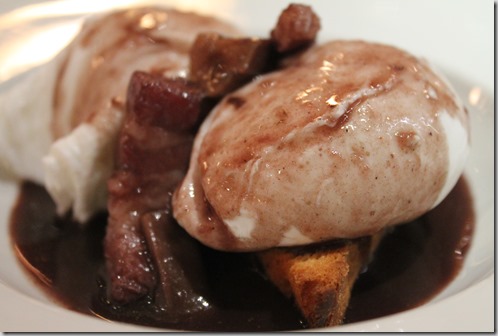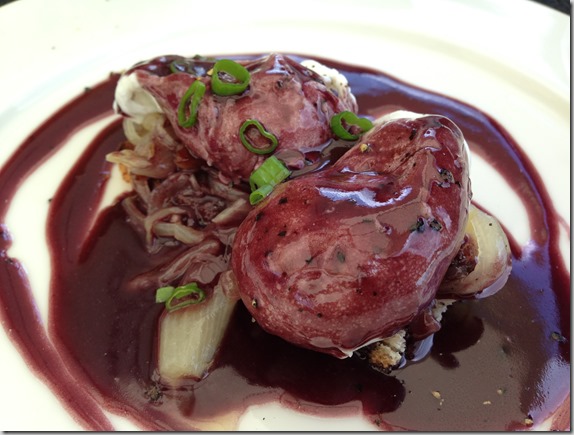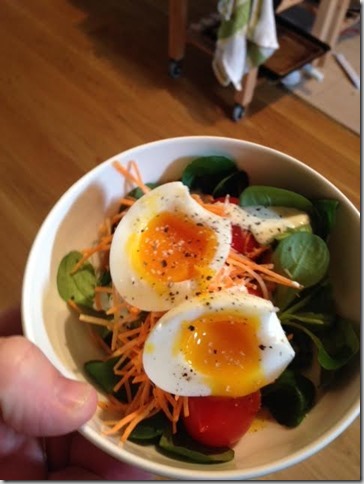If you’ve followed this blog for any time at all, you know that my husband Bo has a passion for cooking. He was raised in a home that appreciated cooking and was introduced to French food and many cooking methods by his mom at an early age. Now, any free weekend night he craves nothing more than spending time in the kitchen with me, experimenting and testing new recipes. He is definitely the stronger cook between the two of us though I’ve learned a few tricks from him in our 11 years together. Starting with today’s post you’ll start seeing more frequent guest posts from him revolving around one of his favorite topics – cooking! Now, without further adieu, I’ll turn it over to Bo!
Many great chefs have written many things about eggs. Perhaps no ingredient other than salt is so often spoken of in cookbooks. However, as an amateur chef, it is actually quite difficult to fully appreciate why this simple ingredient is so lauded by the greatest professionals.
This is not a post on eggs in general but I do feel that it’s important to explain how I’ve finally started to understand the importance of the egg in the culinary arts. I’ve always been a huge fan creating my own omelets. They are a delicious meal at any time of the day and also can be filled with any leftover ingredient in the fridge that are about to be thrown away. Historically, that is largely the extent of my experience with egg cookery.
However, since the beginning of the year, I’ve begun to experiment with custards, sauces of the hollandaise family (including béarnaise sauce, etc.) and the inclusion of eggs in a variety of dishes. In addition, as I read more and more recipes and become more and more experienced in various forms of cooking, understanding the power of the egg in patisserie, as a binding agent for all manner of things from emulsions to breading for meat, and as an ingredient to create volume has become increasingly clear to me.
The general power of the egg aside, this post is about one of the most simple forms of egg cookery though amazingly versatile and totally delicious. I was recently flipping through Julia Childs’ Mastering the Art of French Cooking while looking up the recipe for oeufs en meurette au vin rouge. If you’ve never enjoyed eggs poached in red wine, it is an amazingly delicious dish in which eggs are poached in beef stock and red wine which is then reduced to make a sauce for the eggs.
A few pages in, I came across her description of “6 Minute Eggs”. I have always been a fan of poached eggs; in my opinion they are the perfect way to eat an egg in the morning. If they are cooked properly, the yolks are warm but not yet set, and the whites are gathered and firm. Once it is placed atop a piece of lightly buttered toast, seasoned with some salt and pepper and served with a piping hot cup of coffee and a bit of fresh fruit, it becomes almost the perfect breakfast.
The biggest issue with poached eggs is that they require quite a lot of attention and TLC. In addition, the eggs must be very fresh or the whites will not hold together when dropped in the water. You then must ca\refully monitor the water as it must stay at a very low simmer lest the action of the boiling water damage the egg.
The six-minute egg is not as elegant or impressive as poached eggs if you have guests but it has the identical flavor and texture and is far simpler to cook multiple eggs at once. In addition, if you don’t have experience poaching eggs this is a very easy way to get a similar result. The recipe is literally three simple steps. First, bring a pot of water to boil (enough water to cover the eggs). Second, carefully place as many eggs in the water as you care to cook and place a timer on 6 minutes. Finally, once the timer goes off place take the eggs out of the water with a slotted spoon, and place them in a colander – then run cold water over the eggs to stop the cooking.
The result is an egg in its shell with whites that are firm enough to allow you to peel the shell but a yolk that remains unset and creamy. They can either be consumed immediately when they are still warm, eaten cold (on a salad for example), or reheated by simply placing them in boiling water for about one minute out of the fridge. This has now become a staple in our fridge as making a salad for lunch or dinner has never been easier if you have delicious protein in the form of a gooey egg with which to top the meal. I really hope this is helpful and you all will experiment with adding a six-minute egg to any light dish.
What are your favorite egg dishes?








I couldn’t AGREE MORE – poached eggs are THE BEST THING EVER – however…. I have NO IDEA how to do it!!! UNTIL NOW!!!! I AM GOING TO TRY THIS – your egg looks like utter perfection!
I hope your eggs turn out perfectly! It definitely takes some practice so give yourself time!
OH OH OH YOU KNOW KNOW THIS EGG LOVAH NOW LOVES BO TOO!!!!
🙂 Thanks Carla! Yes, we love eggs too – just like you!
I’m in a constant search for the perfect egg. They seem so easy but are really hard to get just right. Thanks for the tips!
Angela, you’re so right – eggs take practice but are FABULOUS!
I’m going to try this!
I’m going to try this soon! Poaching eggs intimidates me, and this seems easier. :). I love hard boiled eggs mashed on toast with avocados, salt, pepper and a drizzle of olive oil!
The 6 minute egg sounds amazing! Will be trying soon, thanks for sharing!
I hope you love the 6 minute egg as much as we do Laura!